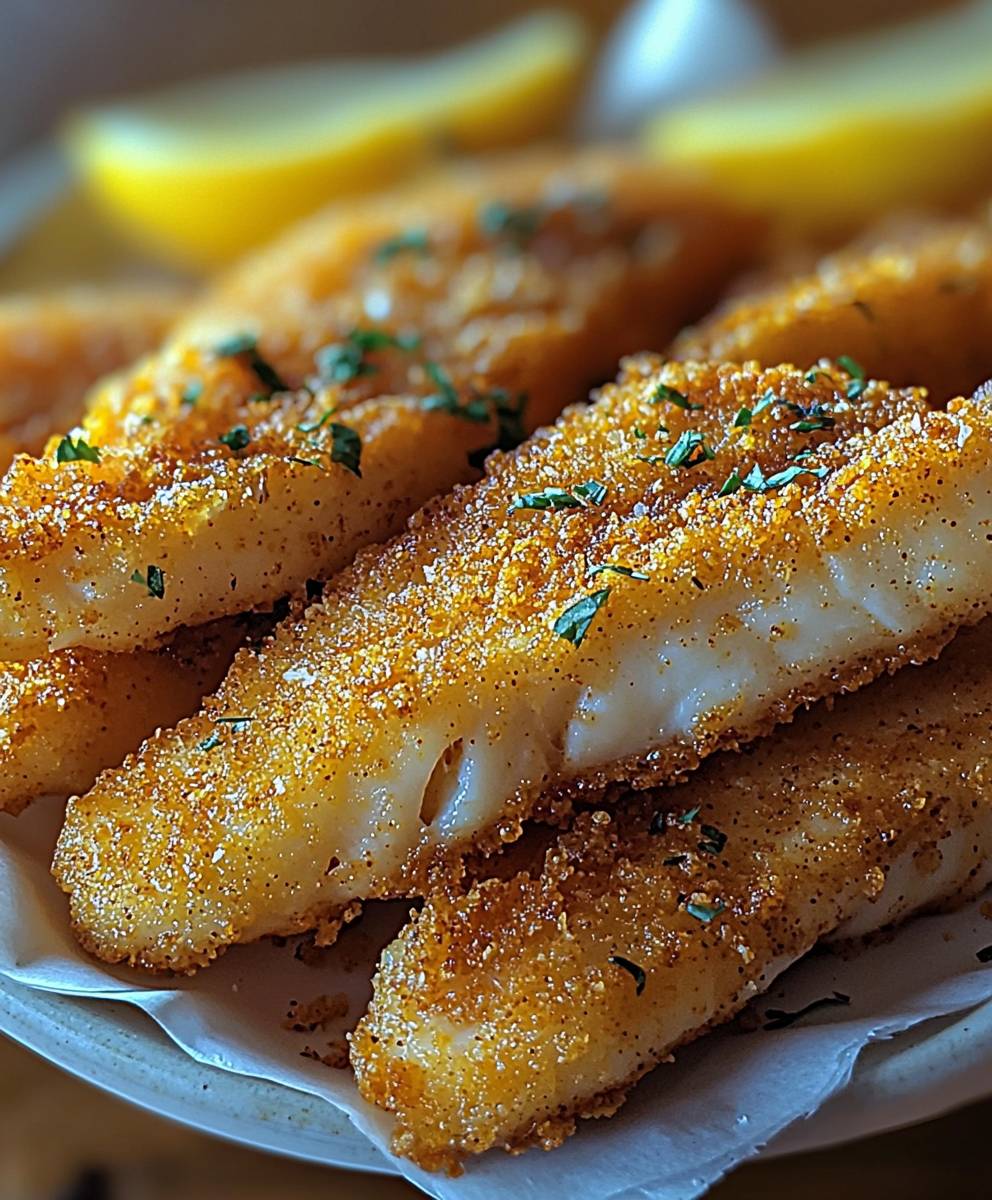Fried Catfish, crispy on the outside and flaky on the inside, is a true Southern comfort food that I’m so excited to share with you! Forget those bland, soggy fish fillets you might have encountered before. This recipe guarantees perfectly cooked, golden-brown catfish every single time.
The history of fried catfish is deeply intertwined with the culinary traditions of the American South, particularly in African American communities. It evolved as a resourceful way to utilize readily available freshwater fish, transforming simple ingredients into a satisfying and flavorful meal. Passed down through generations, this dish represents more than just food; it’s a symbol of heritage and resourcefulness.
What makes this dish so beloved? Well, for starters, the taste is simply irresistible! The crispy, seasoned coating provides a delightful crunch that gives way to the tender, moist catfish within. Its a symphony of textures and flavors that dances on your palate. Beyond the taste, fried catfish is also incredibly versatile. It can be enjoyed as a main course with classic sides like coleslaw and hushpuppies, or as a delicious addition to sandwiches and salads. Plus, with my easy-to-follow recipe, you’ll find that preparing this Southern staple is surprisingly straightforward, making it perfect for a weeknight dinner or a weekend gathering. Get ready to experience the best fried catfish you’ve ever tasted!
Ingredients:
- 4 catfish fillets (about 6-8 ounces each), skin on or off, your preference!
- 1 cup yellow cornmeal
- 1/2 cup all-purpose flour
- 2 tablespoons Cajun seasoning (I like Tony Chachere’s, but use your favorite!)
- 1 tablespoon garlic powder
- 1 tablespoon onion powder
- 1 teaspoon paprika
- 1/2 teaspoon cayenne pepper (optional, for extra heat)
- 1 teaspoon dried thyme
- 1 teaspoon dried oregano
- 1/2 teaspoon black pepper
- 1/2 teaspoon salt (or to taste)
- 1 cup buttermilk
- 1 tablespoon hot sauce (such as Tabasco or Louisiana Hot Sauce)
- Vegetable oil or peanut oil, for frying (about 3-4 cups)
- Lemon wedges, for serving
- Tartar sauce, for serving (optional)
Preparing the Catfish and Breading
- Prepare the Catfish: First things first, let’s get our catfish ready. Pat the catfish fillets dry with paper towels. This is super important because it helps the breading adhere better. If your fillets are particularly thick, you can slice them in half lengthwise to ensure they cook evenly.
- Make the Buttermilk Soak: In a shallow dish, whisk together the buttermilk and hot sauce. The hot sauce adds a subtle kick and helps tenderize the fish. Submerge the catfish fillets in the buttermilk mixture, making sure they are fully coated. Cover the dish with plastic wrap and refrigerate for at least 30 minutes, or up to 2 hours. This soaking process is key for a moist and flavorful final product. The longer it soaks, the more tender it becomes!
- Combine the Dry Ingredients: While the catfish is soaking, let’s prepare the breading. In a large, shallow dish (like a pie plate or a baking dish), whisk together the cornmeal, flour, Cajun seasoning, garlic powder, onion powder, paprika, cayenne pepper (if using), dried thyme, dried oregano, salt, and pepper. Make sure everything is evenly distributed. This is where all the flavor comes from, so don’t skimp on the spices!
- Breading the Catfish: Now for the fun part! Remove the catfish fillets from the buttermilk mixture, letting any excess drip off. One at a time, dredge each fillet in the cornmeal mixture, pressing gently to ensure the breading adheres well to both sides. Make sure every nook and cranny is covered! Place the breaded fillets on a wire rack lined with parchment paper. This allows air to circulate around the fillets, helping them stay crispy.
- Rest the Breading: Let the breaded catfish rest for about 10-15 minutes before frying. This helps the breading set and prevents it from falling off during frying. This is a crucial step for achieving that perfect crispy crust. Don’t skip it!
Frying the Catfish
- Heat the Oil: Pour the vegetable oil or peanut oil into a large, heavy-bottomed skillet or Dutch oven. You want the oil to be about 1-2 inches deep. Heat the oil over medium-high heat until it reaches a temperature of 350-375°F (175-190°C). Use a deep-fry thermometer to monitor the temperature. Maintaining the correct oil temperature is essential for crispy, evenly cooked catfish. If the oil is too cool, the catfish will be greasy. If it’s too hot, the breading will burn before the fish is cooked through.
- Fry the Catfish: Carefully place the breaded catfish fillets into the hot oil, being careful not to overcrowd the pan. Overcrowding will lower the oil temperature and result in soggy catfish. Fry the fillets for about 3-4 minutes per side, or until they are golden brown and cooked through. The internal temperature of the catfish should reach 145°F (63°C).
- Check for Doneness: You can check for doneness by inserting a fork into the thickest part of the fillet. If the fish flakes easily, it’s done. You can also use a meat thermometer to ensure the internal temperature has reached 145°F.
- Remove and Drain: Using a slotted spoon or tongs, carefully remove the fried catfish fillets from the oil and place them on a wire rack lined with paper towels to drain off any excess oil. This helps keep the catfish crispy.
- Repeat: Repeat the frying process with the remaining catfish fillets, making sure to maintain the oil temperature. If the oil temperature drops too low, wait for it to heat back up before adding more fillets.
Serving and Enjoying
- Serve Immediately: Fried catfish is best served immediately while it’s hot and crispy.
- Garnish and Serve: Serve the fried catfish with lemon wedges and tartar sauce (if desired). The lemon juice adds a bright, acidic flavor that complements the richness of the fish.
- Side Dish Suggestions: Fried catfish is delicious with a variety of side dishes. Some popular choices include:
- Coleslaw
- Hushpuppies
- French fries
- Mac and cheese
- Green beans
- Potato salad
- Corn on the cob
- Enjoy! Gather your friends and family, and enjoy your delicious homemade fried catfish!
Tips for Perfect Fried Catfish:
- Use Fresh Catfish: Fresh catfish will always taste better than frozen. If using frozen, thaw it completely before cooking.
- Don’t Overcrowd the Pan: Overcrowding the pan will lower the oil temperature and result in soggy catfish. Fry the fillets in batches.
- Maintain the Oil Temperature: Maintaining the correct oil temperature is crucial for crispy, evenly cooked catfish. Use a deep-fry thermometer to monitor the temperature.
- Don’t Overcook: Overcooked catfish will be dry and tough. Cook it until it’s just cooked through and flakes easily with a fork.
- Season Generously: Don’t be afraid to season the catfish and the breading generously. This is where all the flavor comes from.
- Experiment with Spices: Feel free to experiment with different spices and seasonings to create your own unique flavor profile.
- Keep it Warm: If you need to keep the fried catfish warm before serving, place it in a preheated oven at 200°F (93°C).
- Leftovers: Leftover fried catfish can be stored in the refrigerator for up to 3 days. Reheat it in the oven or air fryer for best results.
Variations:
- Spicy Fried Catfish: Add more cayenne pepper or other hot spices to the breading for a spicier kick.
- Cornmeal-Only Breading: For a gluten-free option, use only cornmeal for the breading.
- Oven-Fried Catfish: For a healthier option, bake the breaded catfish in the oven instead of frying it. Preheat the oven to 400°F (200°C). Place the breaded catfish on a baking sheet lined with parchment paper. Drizzle with olive oil and bake for 15-20 minutes, or until golden brown and cooked through.
- Air Fryer Catfish: Another healthier option is to use an air fryer. Preheat your air fryer to 400°F (200°C). Spray the breaded catfish with cooking spray and place it in the air fryer basket. Cook for 12-15 minutes, flipping halfway through, or until golden brown and cooked through.
Troubleshooting:
- Breading Not Sticking: Make sure the catfish is patted dry before breading. Also, make sure the buttermilk soak is coating the fish evenly. Letting the breaded fish rest before frying also helps.
- Catfish is Greasy: The oil temperature was likely too low. Make sure the oil is hot enough before adding the catfish. Don’t overcrowd the pan.
- Breading is Burning: The oil temperature was likely too high. Lower the heat and monitor the temperature closely.
- Catfish is Dry: The catfish was likely overcooked. Cook it until it’s just cooked through and flakes easily with a fork. Soaking in buttermilk helps prevent dryness.

Conclusion:
And there you have it! This isn’t just another fried fish recipe; it’s a gateway to crispy, golden-brown perfection that will have everyone at the table begging for seconds. I truly believe this fried catfish recipe is a must-try because it delivers on flavor and texture in a way that’s both satisfying and surprisingly simple. We’ve taken the guesswork out of achieving that perfect crunch and tender, flaky interior. Forget soggy, bland fish this recipe guarantees a delightful culinary experience.
But the best part? This recipe is incredibly versatile! While I personally adore serving it with classic sides like creamy coleslaw, hushpuppies, and a generous dollop of tartar sauce, the possibilities are truly endless. For a lighter meal, try pairing it with a fresh garden salad and a squeeze of lemon. If you’re feeling adventurous, consider making catfish tacos with shredded cabbage, pico de gallo, and a spicy chipotle mayo. The crispy texture and mild flavor of the catfish make it a fantastic addition to so many different dishes.
Looking for variations? You can easily adapt the seasoning blend to suit your own preferences. Add a pinch of cayenne pepper for a little kick, or incorporate some smoked paprika for a deeper, more complex flavor. Experiment with different types of cornmeal a coarser grind will result in an even crispier coating. And if you’re looking for a gluten-free option, simply substitute the all-purpose flour with a gluten-free blend.
Beyond the sides and spices, consider the dipping sauces! While tartar sauce is a classic for a reason, don’t be afraid to branch out. A tangy remoulade sauce, a sweet and sour chili sauce, or even a simple aioli can elevate your fried catfish to a whole new level. Think about what flavors complement the fish and let your creativity guide you.
I’m so confident that you’ll love this recipe, and I can’t wait to hear about your experiences! Seriously, give it a try. Gather your ingredients, follow the simple steps, and prepare to be amazed by the results. It’s the perfect dish for a weeknight dinner, a weekend gathering, or any occasion that calls for a little bit of Southern comfort food.
Once you’ve tried it, please, please, please come back and share your thoughts in the comments below! Did you make any modifications to the recipe? What were your favorite sides and dipping sauces? What did your family and friends think? Your feedback is invaluable, and it helps me to continue creating recipes that you’ll love. I’m always eager to learn from your experiences and see how you’ve made this recipe your own.
So, what are you waiting for? Get in the kitchen and start frying! I promise you won’t regret it. This fried catfish is destined to become a new family favorite. Happy cooking! And don’t forget to snap a picture of your culinary masterpiece and share it on social media using [Your Hashtag Here] I’d love to see your creations!
Fried Catfish: The Ultimate Guide to Crispy Perfection
Crispy, golden-brown fried catfish with a flavorful Cajun-spiced cornmeal crust. A Southern classic, perfect with lemon wedges and tartar sauce!
Ingredients
- 4 catfish fillets (6-8 ounces each), skin on or off
- 1 cup yellow cornmeal
- 1/2 cup all-purpose flour
- 2 tablespoons Cajun seasoning (such as Tony Chachere’s)
- 1 tablespoon garlic powder
- 1 tablespoon onion powder
- 1 teaspoon paprika
- 1/2 teaspoon cayenne pepper (optional)
- 1 teaspoon dried thyme
- 1 teaspoon dried oregano
- 1/2 teaspoon black pepper
- 1/2 teaspoon salt (or to taste)
- 1 cup buttermilk
- 1 tablespoon hot sauce (such as Tabasco or Louisiana Hot Sauce)
- Vegetable oil or peanut oil, for frying (3-4 cups)
- Lemon wedges, for serving
- Tartar sauce, for serving (optional)
Instructions
- Prepare the Catfish: Pat catfish fillets dry with paper towels. Slice thick fillets lengthwise.
- Make Buttermilk Soak: In a shallow dish, whisk together buttermilk and hot sauce. Submerge catfish in the mixture, cover, and refrigerate for 30 minutes to 2 hours.
- Combine Dry Ingredients: In a large, shallow dish, whisk together cornmeal, flour, Cajun seasoning, garlic powder, onion powder, paprika, cayenne pepper (if using), thyme, oregano, salt, and pepper.
- Breading the Catfish: Remove catfish from buttermilk, letting excess drip off. Dredge each fillet in the cornmeal mixture, pressing gently to coat. Place breaded fillets on a wire rack lined with parchment paper.
- Rest the Breading: Let the breaded catfish rest for 10-15 minutes.
- Heat the Oil: Pour oil into a large, heavy-bottomed skillet or Dutch oven to a depth of 1-2 inches. Heat over medium-high heat to 350-375°F (175-190°C).
- Fry the Catfish: Carefully place breaded catfish fillets into the hot oil, being careful not to overcrowd the pan. Fry for 3-4 minutes per side, or until golden brown and cooked through (internal temperature of 145°F/63°C).
- Check for Doneness: Insert a fork into the thickest part of the fillet. If the fish flakes easily, it’s done. You can also use a meat thermometer to ensure the internal temperature has reached 145°F.
- Remove and Drain: Remove fried catfish with a slotted spoon or tongs and place on a wire rack lined with paper towels to drain.
- Repeat: Repeat frying with remaining fillets, maintaining oil temperature.
- Serve Immediately: Serve hot with lemon wedges and tartar sauce (optional).
- Side Dish Suggestions: Coleslaw, Hushpuppies, French fries, Mac and cheese, Green beans, Potato salad, Corn on the cob.
Notes
- Patting the catfish dry is crucial for breading adhesion.
- Soaking in buttermilk tenderizes the fish and adds flavor.
- Resting the breaded catfish helps the breading set and prevents it from falling off during frying.
- Maintain the correct oil temperature for crispy, evenly cooked catfish.
- Don’t overcrowd the pan to prevent soggy catfish.
- Serve immediately for the best taste and texture.
- Use a deep-fry thermometer to monitor the temperature.
- If you need to keep the fried catfish warm before serving, place it in a preheated oven at 200°F (93°C).
- Leftover fried catfish can be stored in the refrigerator for up to 3 days. Reheat it in the oven or air fryer for best results.






Leave a Comment